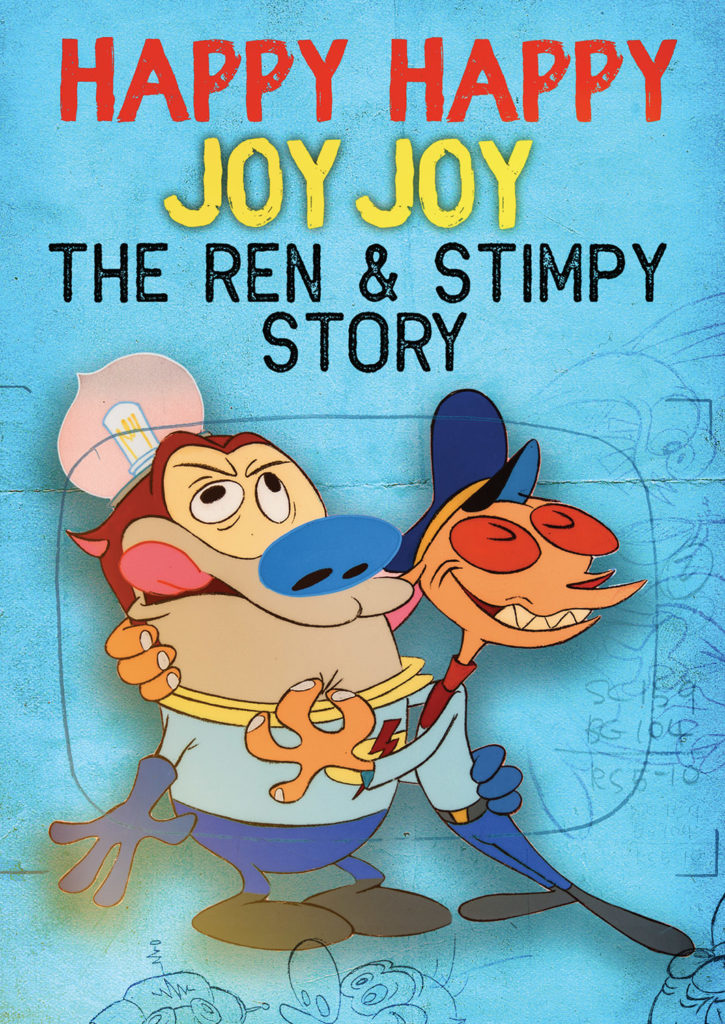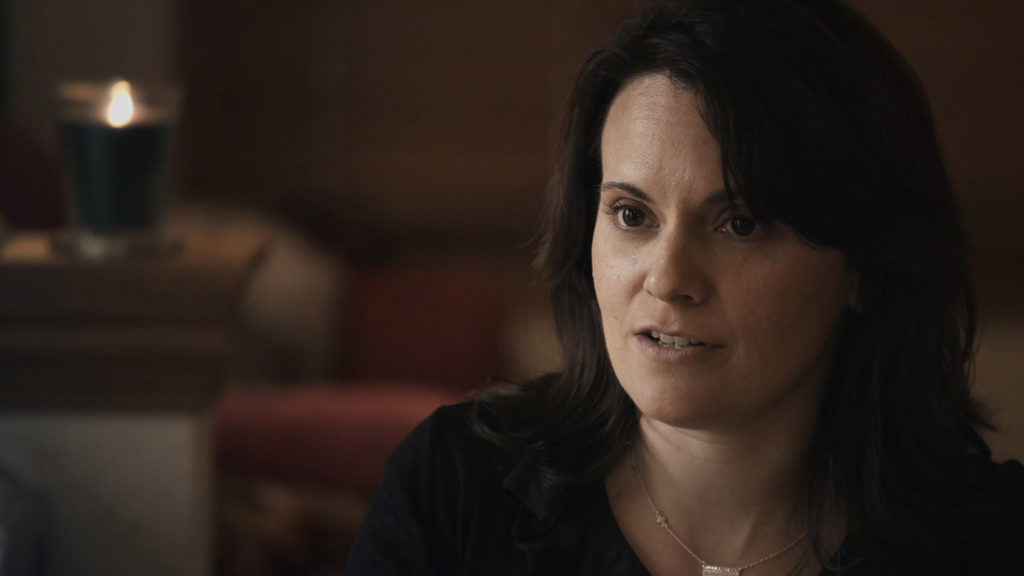An Engaging Look At A Cartoon Favorite And Its Creator That Doesn’t Measure Up To Its Potential
DIRECTED BY KIMO EASTERWOOD AND RON CICERO/2020
DVD STREET DATE: December 15, 2020

Ren & Stimpy, the hit animated series that single-handedly revitalized the stagnant television animation industry in the early 90s. John Kricfalusi, the avant-garde creative genius, inventive artist, domineering director, and sexual predator who created it. The careers born from and lives harmed by both.
These are the stories that Happy Happy Joy Joy: The Ren & Stimpy Story attempts to tell. A pop-documentary covering the creation and history of John Kricafalusi’s The Ren & Stimpy Show, Happy Happy Joy Joy has the unenviable task of being a celebration of Kricfalusi’s best known creation, while also addressing his long history of grooming and sexual misconduct. It’s a difficult balance that in some ways it manages, and despite my at times harsh criticisms I want to say right off the bat that I do enjoy this film. However, its inability to commit to a critique of Kricfalusi harms more than helps, leaving it muddled and far less than it could be.
Happy Happy Joy Joy is constructed around interviews, primarily with those who worked on the Ren & Stimpy as well as some celebrity fans of the show. Most notable among these subjects is series creator and director for the first two seasons John Kricfalusi, who is the lens through which much of the story is filtered. The “Andy Warhol of animation” – as one Ren & Stimpy artist refers to him – spends much time discussing his personal experiences. How influenced he was by his aggressive, disapproving father, his time with Ren & Stimpy from his days working on the series to his firing due to managerial incompetence, often making excuses for his managerial incompetence and casual cruelty.

Another major subject is Vanessa Coffey, the Nickelodeon producer who approved the series and actually selected the characters of Ren and Stimpy from Kricfalusi’s Our Gang pitch to be developed further into the stars of their own series. It is Coffey that pushed the staff to make some of the more standout emotional moments that would enhance the comedy, undercutting Kricfalusi’s disdain for such things. Coffey would also suffer a great deal of abuse trying to work with the notoriously ill-tempered director and from his fans following Kricfalusi’s removal from the project. Abuse from Kricfalusi is a common theme throughout the documentary, as artists discuss his obsessive directorial style and vicious critiques, elements which took a toll on animators while pushing the series further and further behind schedule.
In its final segment, professor and former animator Robyn Byrd discusses her own experiences with the manipulative director. How Kricfalusi took advantage of her as a young Ren & Stimpy fan, sexually harassing and coercing her into becoming his live-in girlfriend when she was only 16. How Kricfalusi would continue to do this to countless other aspiring artists like Katie Rice for years. These despicable actions and the failure of all of Kricfalusi’s succeeding projects are how Happy Happy Joy Joy closes. But the interview subjects add that they hope those who had affection for the series don’t see it as totally stained by the contributions of Kricfalusi, and that the hard work of the myriad other artists who contributed to the series can still be appreciated.

Happy Happy Joy Joy is a film that I can’t help but be frustrated by. It succeeds in some of its aims, creating a dramatic if a bit amorphous narrative arc covering the history and development of the series, its eventual disintegration, and the creator’s fall from grace. It certainly doesn’t shy away from directly confronting Kricfalusi with his sexual misconduct and grooming of minors as his interviewers allow him to insert his foot in his mouth as he tries and fails to excuse his actions. And – even if it feels a bit tacked on – it does try to take away some of Kricfalusi’s mythologized significance, with an attempt to call attention to the other creative talents who directly contributed to the success of Ren & Stimpy, if somewhat limply.
Yet, it still presents itself as ostensibly something “for fans”, in that it omits much context for how Kricfalusi was able to rise to a position where he could be showrunner on Ren & Stimpy. The spiritual predecessor to Ren & Stimpy – the Ralph Bakshi produced Mighty Mouse: The New Adventures – is never mentioned throughout the runtime of the documentary, nor is Bakshi himself. This is despite the fact that it was Bakshi’s significance in revolutionizing the American animated feature and his long career as a boundary pushing director that afforded him the clout to produce the revolutionary Mighty Mousereimagining. That it was that series which launched countless careers and its incredibly positive critical reception that would in turn allow Kricfalusi – senior director on Mighty Mouse’s first season – to parley that experience and recognition into the better known Ren & Stimpy.
A picture featuring Ralph Bakshi with Kricfalusi actually does appear in the film; however it is cropped to excise Bakshi, the focus solely on Kricfalusi. The reason this absence is so frustrating is that it adds to a larger problem with the film’s lack of a unified thesis. It tries to have it both ways, painting Kricfalusi as an avant-garde genius while never really committing to the importance of the other creatives on the series. If greater emphasis was placed on undercutting this notion of “Kricfalusi the Troubled Genius”, disproving myths of his significance and reapportioning credit to those who came before him, his contemporaries, and those who worked with him, one can’t help but think the film would have a stronger thesis.

Unfortunately, it can’t do that. With its sidebars to celebrities praising the series and superfans with mountains of merchandise, it’s clear that Happy Happy Joy Joy wants to be a love letter to Ren & Stimpy as much as it wants to be a critique of John Kricfalusi, yet the filmmakers don’t realize that they can commit to both. The story of Ren & Stimpy seemingly ends when Kricfalusi leaves the series, despite three more seasons of it being produced that were overall quite good in their own right. There are the bones of a documentary which addresses the monstrous acts of Kricfalusi, reclaims the original series from him, and works to dispel the mythology of his significance to the world of animation. A film which questions the boy’s club attitude that could have allowed Kricfalusi to groom and sexually harass minors for years, an open secret that wasn’t addressed until his victims could muster the incredible courage to address his actions themselves.
But instead, what we end up with is a messy pop-documentary, something caught between the history and the myth of Ren & Stimpy. An enjoyable one, certainly; one where we are offered a well-produced peek behind the curtain at the lives of the people who made Ren & Stimpy and how they went about it, the man who pitched it and directed two of its five seasons, and the enthusiasm and fervor for it at the time of its original release. And despite its failings the film does manage to not feel like a complete mess despite beginning as a celebration of the series and look at a controversial director, which later had to pivot to address his history of abuse.
For those interested in the basic history of Ren & Stimpy,fans of the series, and fans of animation I do recommend they seek this film out. The DVD release by Kino especially, which is well presented and includes more than an hour of interviews with seriesartists that didn’t make it to the final film and paints a more complete picture of the story of Ren & Stimpy for those interested. However, I can’t help but feel it could have been so much stronger if it had, like Ren & Stimpy, been more daring.

